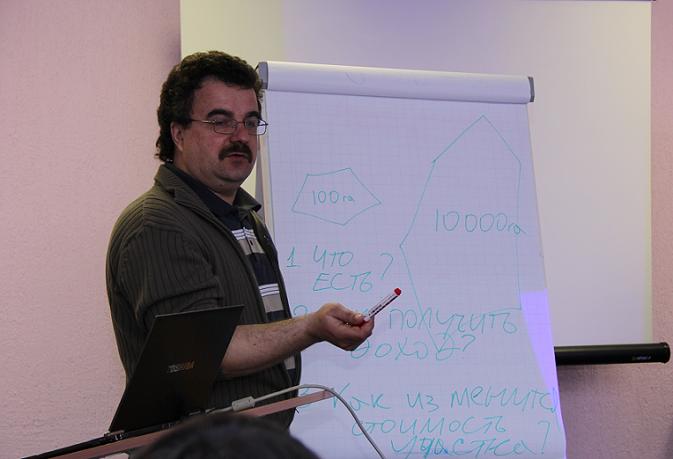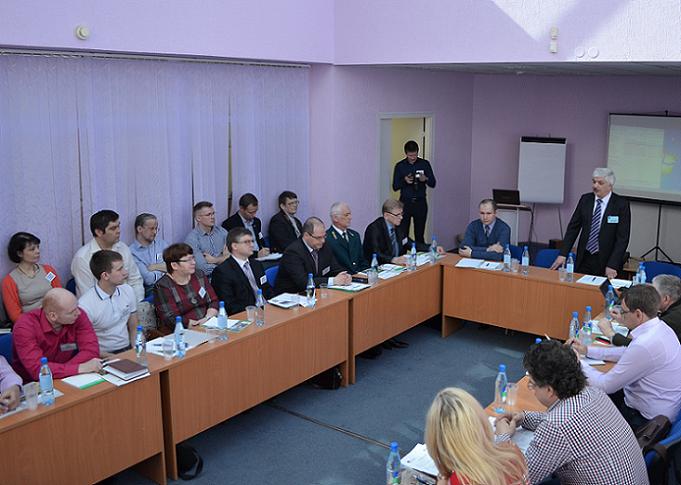“Forestry Intensification: Prospects and Limitations in the Komi Republic”
That was the name of the regular republican Forest dialogue, organized on April 23-24, 2015 by the Silver Taiga Foundation jointly with Mondi Syktyvkar.
The Forest dialog is a platform for discussing the topical issues related to the forest management and use, where each stakeholder has an equal opportunity to participate in a debate on problems. The meetings in this format have been held in the republic on the initiative of the Silver Taiga over the last five to six years. Over this period of time, the Forest dialog has become an efficient form of public participation, exchange of opinions, and joint search for the optimal ways to address the current problems by different stakeholders.
This time 45 participants took part in the dialogue. These were the representatives of the local self-government bodies and population of the forest districts, Forest Committee and Ministry of Industry and Energy of the Komi Republic, environmental non-governmental organizations – World Wildlife Fund and Silver Taiga Foundation, Interregional Public Movement “Komi Voytyr”, specialists of Mondi Syktyvkar, Luzales company, and other forest sector enterprises, employees of the Institute of Socio-Economic and Energy Problems of the North, Syktyvkar Forest Institute, intensive forestry specialist experts, and journalists.
IF – what is it?
The first part of the meeting was devoted to presentation of the reports on the topic of the dialogue. An acquaintance with the topic started with the philosophy of the intensive forestry and determination of its essence, revealed by the IF expert Pavel Bezverkhov (“Forest alternative”, Tikhvin, Leningrad region). Further, the participants of the dialog got the opportunity to learn about the intensive forestry models functioning in the boreal forests. The Director of the Silver Taiga Foundation Yury Pautov showed a film on the history of the intensive forestry formation in Sweden and introduced a presentation about the special features of the Finnish model of IF. It is clear from what the participants saw and heard at the meeting that in both cases the leading role in the transition to the intensive forestry was played by the state. This is despite the fact that in both northern countries the state is not the only forest owner. In Finland, more than half of the forested area belongs to private forest owners, and in Sweden, more than 80 percent of the forests are privately owned.
The meeting was naturally continued with the discussion of the prospects for the intensive forestry development in Russia and the state’s position in this matter. The Head of the WWF Forest Program Nikolai Shmatkov and the Head of the Forest Committee of the Komi Republic Andrei Shlyamin, having presented the Federal forestry intensification program, did their best to cover this topic and answer numerous questions of the dialogue participants.
The main advantage of the intensive forestry, from the point of view of ecologists, is the possibility to preserve the last intact forest massifs of the highest ecological value, which are disappearing at an alarming rate during the pioneer extensive exploitation. For example, according to WWF data, only for thirteen years (from 2000 to 2013) Russia has lost 21 million ha of valuable pristine forests. Of course, forest management on the woodlands that have already been exploited and are located closer to the roads, settlements, and processing centers will have both economic and social benefits, because it will provide an opportunity for revival of the rural areas, which are, in fact, left struggling for survival these days. Recognizing this, the Russian environmental non-governmental organizations have been promoting the idea of gradual transition of the country’s forestry to the intensive model for a number of years now.
Considering the fact that the state is the only forest owner here, which means that it is the state who is most interested in the effective forestry, one would logically expect it to undertake active steps in this direction. However, judging by the federal program of the forestry intensification, our state is not ready to invest in this process. All actions in this direction are transferred to a leaseholder without provision of any incentive mechanisms. As noted by Pavel Bezverkhov during the discussion, “we have the state, federal ownership of the forests with non-state activity”.
The Komi Republic is no exception
Here the process is also initiated by a business community, represented by Mondi Syktyvkar, and non-governmental organizations. Although, a few years ago, upon the request of the regional Forest Committee, Tekhkarta Company carried out zoning of the republic’s territory in terms of the intensive forestry expediency and identified intensive and extensive forestry zones. The results of this work were presented to the Forest Dialogue participants by the Director of Tekhkarta Company Alexey Serov.
According to A. Shlyamin, currently, a selection of forest areas, on which the main leaseholder – Mondi Syktyvkar – will carry out the experimental work, is ongoing. A. Shlyamin replied to the question of how the state envisions the intensive forestry introduction on the not leased areas, that, in his opinion, the state does not have a view of the forestry as a separate branch of industry so far: “This view is only beginning to take shape. I think that gradually it will come to the rest of the forestry. This requires understanding that the forestry is not the place to bury money, but an independent branch of economy.” As of the Komi Republic, according to the Head of the Forest Committee, an allocation of appropriate sites for the intensive forestry introduction on the territories that are not leased out is also under discussion at the moment.
The First Deputy Minister of Industrial Development, Transport and Communications Alexander Gibezh also agreed with the need for a transition towards the intensive forestry: “I have a feeling that we are already close to the point, reached by the Finns and Swedes, when they started thinking about a fundamental change of the approaches to the forest management.” In his presentation at the Forest Dialogue, Alexandr dwelt upon the problem, which is always encountered during the transition to an intensive forest management model, – the potential for the use of the small-diameter timber in the republic.
An economic justification of the need for the transition to the intensive forest management on the leased area was provided in the report of Vasily Chuprov, the Head of the Wood supply department of Mondi Syktyvkar. V. Chuprov stated that it is the economic feasibility that is forcing them to switch to the intensive forestry. The forests are further and further away from the mill, and an average haul distance is already 240 km away. Precisely for that reason, Mondi Syktyvkar is passing from talking about the intensification to practical steps on the IF introduction, hoping that other participants of the forest relations, and, above all, the forest owner – the state – will also deliberately join this complex process.
What hinders the forestry intensification?
A large part of the time, allocated for the Forest dialog, was devoted to the work in two sections, where a more detailed discussion of the topic was held. In one of them the debate was focused on the economic aspects of the intensive forestry, in another – on social and environmental aspects. In spite of some disagreements in details, all participants of the Forest Dialogue agreed that the transition from an extensive to intensive forestry model is necessary and inevitable. Otherwise, it is not long before the forest industry will find itself in a dead-end situation, without economically available resource. The point is to realize it earlier than this foreseeable dead-end situation happens, and facilitate the process of transition to the intensive forestry as much as possible.
The actions of the state, which is the only forests owner in the country, bear little resemblance to the forest owner’s behavior. On the one hand, the state declares the need of the intensive forestry introduction, on the other hand, – offers no mechanisms of such transition – neither economic nor normative, nor financial. It turns out that the forest owner shifts all efforts and expenses for the transition to the intensive forestry to the leaseholder without any motivation. As for the transition to the intensive forestry on the forest areas that are not leased out, it is out of the question for now. Meanwhile, these are the woodlands that have already been exploited and are not leased out at the moment, where the intensive forestry makes the most sense, since they are closer to the settlements, roads, and processing centers.
The participants of the dialog agreed that the lack of a unified understanding of the IF and common approach to its implementation among the forest industry specialists do not contribute to the transition to the intensive forestry either. The existing system of lease relations with not ensured payback of the investments and no long-term interest in a forest area capitalization on the part of a leaseholder is also not conducive to the intensive forestry development.
Discussing the obstacles on the path to the intensive forestry, the participants highlighted the need for additional justification of an optimal felling age. In the opinion of Vladimir Pakhuchy (Forest Institute), this is one of the major issues, because the IF can be replaced by bringing down the felling age. P. Bezverkhov substantiated this from an economic point of view: “When we reduce the felling age, we decrease the forest area cost, because in some years we would have received from this area significantly more than now. Besides, in case of the felling age reduction, we would have to invest more money in the future. In other words, this is a temporary, “freaky” option of use.”
In the course of the discussion, some other factors hindering the transition to the intensive forestry have also been mentioned. Among other things, it was noted that the society has not yet realized the need for such transition, because the population is not sufficiently informed about this.
It is better to learn from the mistakes of others
During the discussion, the participants of the dialog have repeatedly referred to the experience of other boreal countries. That is not surprising, bearing in mind the saying that to learn from the mistakes of others is a chance to avoid your own. The experience of other countries shows that the intensive forestry focused only on obtaining the maximum “timber harvest” may result in a loss of the biological diversity, deterioration of the environmental forests properties, and soil and water resources quality. The outcome document of the Forest dialog contains the proposals for avoiding such consequences. This is a landscape forestry planning on the selected territory, with account of the social and environmental limitations and stakeholders’ opinions, as well as identification of the most ecologically valuable areas at the planning stage, their mapping, and conservation of the key biotopes on the local level.
When discussing the socio-ecological aspects, much attention was given to the options of forest management in the socially significant forests. On the one hand, these forests are accessible and important for the population, on the other hand, – most profitable in terms of investment in the intensive forestry. However, currently the forest management is almost missing in these forests: there are no forest management plans, the forests are logged chaotically around the villages, the most accessible and profitable forest plots are gradually losing their ecological and economic value. What can be done about this? In the course of the dialog, the idea of the Model Forest Village project – forest management in the social forests by a community, local enterprise, local economic entity – was born. In Sweden, Finland, Germany and other countries, there are numerous examples of the “community forestry”, when the earnings from the management and use of the forests around the settlements come to the budgets of these settlements. 10 thousand ha is a sufficient area to ensure the viability of this option. Of course, prior to the implementation of this “model project”, all losses and gains need to be calculated, and all possible risks – considered.
From talks – to real actions
The participants of the dialog have discussed and proposed specific recommendations for the transition from the extensive to intensive forestry model in the Komi Republic. Among them – establishing demonstration sites in close proximity to Syktyvkar, which will serve for showing and dissemination of the intensive forestry idea, thus, transferring the knowledge about this to all stakeholders; establishing a transport accessible landscape test site of a sufficient area (15-25 thousand ha) with a designed full-cycle IF, taking in account the environmental and social restrictions; developing a “model project” of the intensive forestry management in the “social” forests, located near settlements, with an active involvement of the local population…
The Forest dialogue participants have also suggested considering and discussing the idea and mechanism of money return from logging to the forestry, which is critically important for the intensive forestry development, at the conferences of the Interregional Public Movement “Komi Voytyr” and other public interest platforms.
The Federal Forestry Agency was suggested to try out the Latvian system for the transition to the IF in one of the regions of the European part of Russia, through the creation of a government business enterprise that will run the forest management, on the basis of the existing forest management bodies.
The participants of the dialog hope that these and other specific proposals and recommendations will help to move from talking about the forestry intensification to real steps towards its implementation.
“Such discussions help to form an attitude”
In conclusion of the discussion, its participants noted the pros and cons of the conducted Forest dialogue.
Here are a few opinions:
– The only thing missing for a more meaningful and substantive talk was a “forest component” – a trip to the forest and joint discussion of the problem through the example of a specific forest area (P. Bezverkhov, LLC “Forest alternative”).
– If we want our officials to fully participate in the dialogue, we should arrange the discussion in the first part of the event, otherwise it appears that most of them don’t stay until the debate (A. Serov, Tekhkarta Company).
– Everything was very useful. I will include a lot in my courses. I hope that our recommendations will go beyond the borders of the Komi Republic (V. Pakhuchy, Syktyvkar Forest Institute).
– The dialogue was fruitful and useful. It is deplorable that our capabilities are not in demand by the forest owner so far. But, if you remember, the first steps towards the certification were also not accepted by it. However, they proved to be needed to a leaseholder – because of an economic interest. And here it is also important to help to see this economic interest (D. Kutepov, an independent consultant).
– It is a good thing that the forestry intensification has become a subject of the Forest dialog. This is important, because there is still no common understanding of this matter. I think that over these two days the topic was covered from all aspects. Unfortunately, a social aspect has not been sufficiently discussed due to the lack of time (V. Chuprov, Mondi Syktyvkar).
– I have not even suspected that I know so little about the forest and forestry. The dialog was very useful (V. Mikhaylov, the Public Forest Council, village Keros, Kortkeros district).
– The discussion was a bit lacking consistency, but a free debate is not always a bad thing. It is in such free discussions that radical swings, principled approaches, and innovations are born. Such debates help to form a position and affect the formation of the society’s attitude towards the forestry. Today, the society does not understand what the forestry is dealing with. If there were understanding and support on the part of the society, no one would be able to “corner” the forestry (A. Navalikhin, Forest Committee of the Komi Republic).
The presentations, submitted at the Forest dialogue, are available for downloading in PDF format below (in Russian):
- ФThe intensive forestry philosophy
- The history of the forestry intensification in Finland
- The prospects for the intensive and sustainable forestry development in Russia: WWF’s vision
- The federal program of the intensive forestry
- The opportunities for using the wood generated as a result of the forestry intensification in the Komi Republic
- Dividing the territory of the Komi Republic into the intensive and extensive forestry zones
- The forestry intensification experience at Mondi Syktyvkar
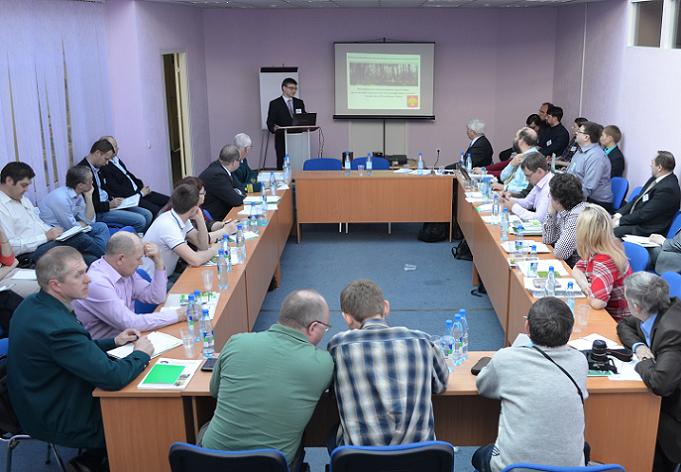
The First Deputy Minister of Industrial Development, Transport and Communications A. Gibezh is describing the prospects for the use of small-diameter timber in Komi
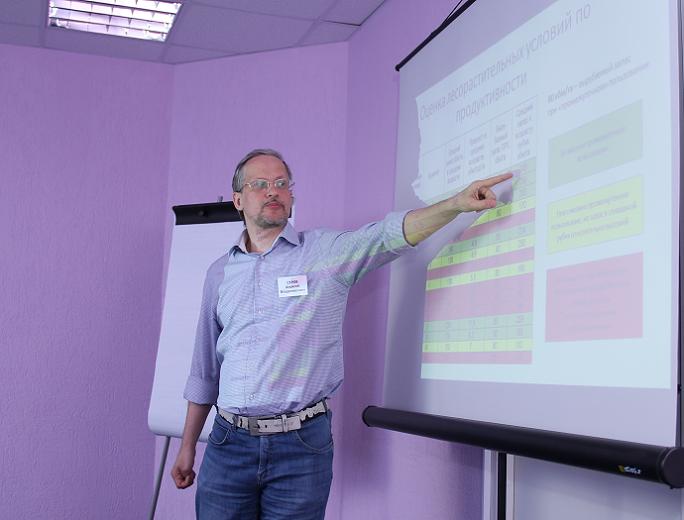
A. Serov is introducing the participants of the dialog to the outcomes of the work on the zoning of the territory of the Komi Republic for the intensive forestry implementation
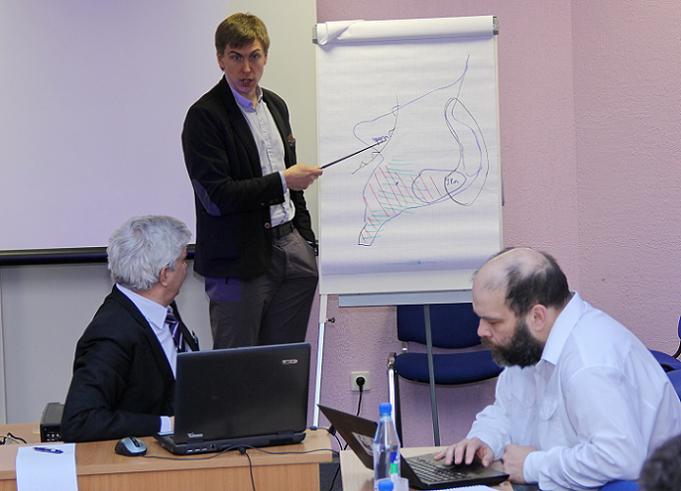
D. Popov is telling about the prospects for the IF introduction in the areas of Mondi Syktyvkar activities
Valentina Semyashkina,
Photo by Sergey Davydov and Denis Popov
Translated by Irina Sokolova

